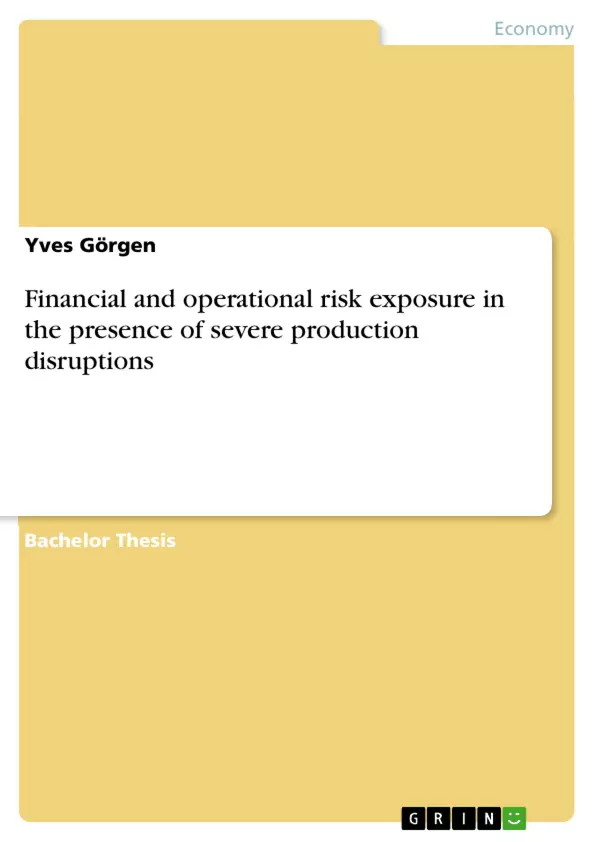Driven by the case of a pharmaceutical company, this thesis examines the effect of severe production process disruptions over the market cycle of a high-margin product.
Using Monte Carlo simulation, the financial, as well as operational risks and performance implications, are quantified under various scenarios. Thereby, the model includes the possibility of repeated disruptions based on stochastic occurrences and the resulting short and long-term consequences due to the availability of substitutes.
Besides, the study evaluates appropriate risk management strategies based on safety stock policies and different risk preferences of the decision-maker. The results indicate rather moderate implications on expected profits due to production disruptions but a substantial impact on the downside risk for a firm. The optimal inventory policy depends significantly on the disruptions parameters, characteristics of the firm and risk appetite of the decision-maker and cannot be generalized. In case of a highly profitable product, conservative inventory policies are advantageous, as they do not only mitigate risks but also lead in most scenarios to a higher expected profit than lean policies.
Inhaltsverzeichnis (Table of Contents)
- Introduction
- Background and Review of Related Literature
- The Importance of Inventories
- Overview of Supply chain Disruptions
- Assessing the Impact of Supply chain Disruptions
- Managing and Mitigating Supply chain Disruptions
- Case study: An Aseptic Production process of a Pharma-ceutical company
- Methodology
- Description of the Base Model
- Simulation Methodology and Production Disruption measures
- Analysis and Results
- Illustration of the Risk Exposure
- Sensitivity Analysis
- Risk Management Strategies based on different Scenarios
- Conclusion and Outlook
- Conclusion and Discussion of the Results
- Limitations and Outlook for further Research
Zielsetzung und Themenschwerpunkte (Objectives and Key Themes)
This thesis aims to investigate the financial and operational implications of severe production process disruptions within a pharmaceutical company. Using Monte Carlo simulation, the study quantifies the impact of these disruptions under various scenarios, considering factors like repeated occurrences, availability of substitutes, and risk management strategies.
- Impact of production disruptions on financial and operational performance.
- Quantification of risks and performance implications under different scenarios.
- Evaluation of risk management strategies based on safety stock policies and risk preferences.
- Analysis of the interplay between disruption parameters, firm characteristics, and decision-maker preferences.
- Impact of conservative inventory policies on mitigating risks and maximizing expected profits.
Zusammenfassung der Kapitel (Chapter Summaries)
- Introduction: This chapter provides an overview of the research topic and its significance in the context of pharmaceutical production.
- Background and Review of Related Literature: This chapter delves into the importance of inventories, explores the nature of supply chain disruptions, and discusses methods for assessing and managing their impact.
- Case study: An Aseptic Production process of a Pharma-ceutical company: This chapter describes the specific case study of an aseptic production process within a pharmaceutical company, providing a detailed description of the system and its characteristics.
- Methodology: This chapter outlines the methodology used in the study, including the description of the base model, the simulation methodology, and the production disruption measures employed.
- Analysis and Results: This chapter presents the results of the simulation analysis, illustrating the risk exposure and conducting a sensitivity analysis. It also examines different risk management strategies and their effectiveness.
Schlüsselwörter (Keywords)
This thesis focuses on the critical concepts of production disruptions, financial and operational risk, Monte Carlo simulation, risk management strategies, safety stock policies, and the impact of disruptions on profitability and risk exposure within the context of a pharmaceutical company.
- Quote paper
- Yves Görgen (Author), 2020, Financial and operational risk exposure in the presence of severe production disruptions, Munich, GRIN Verlag, https://www.grin.com/document/888726



